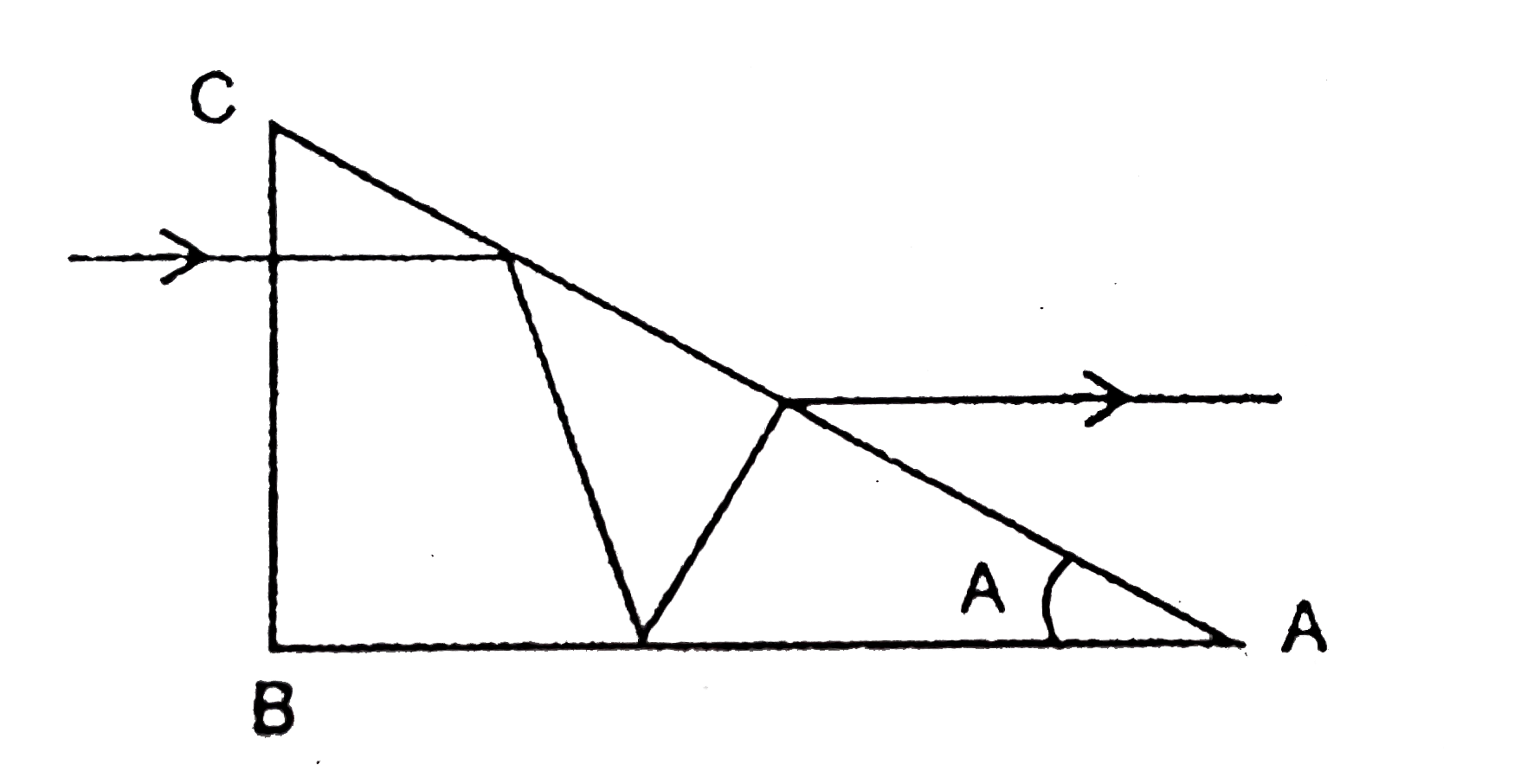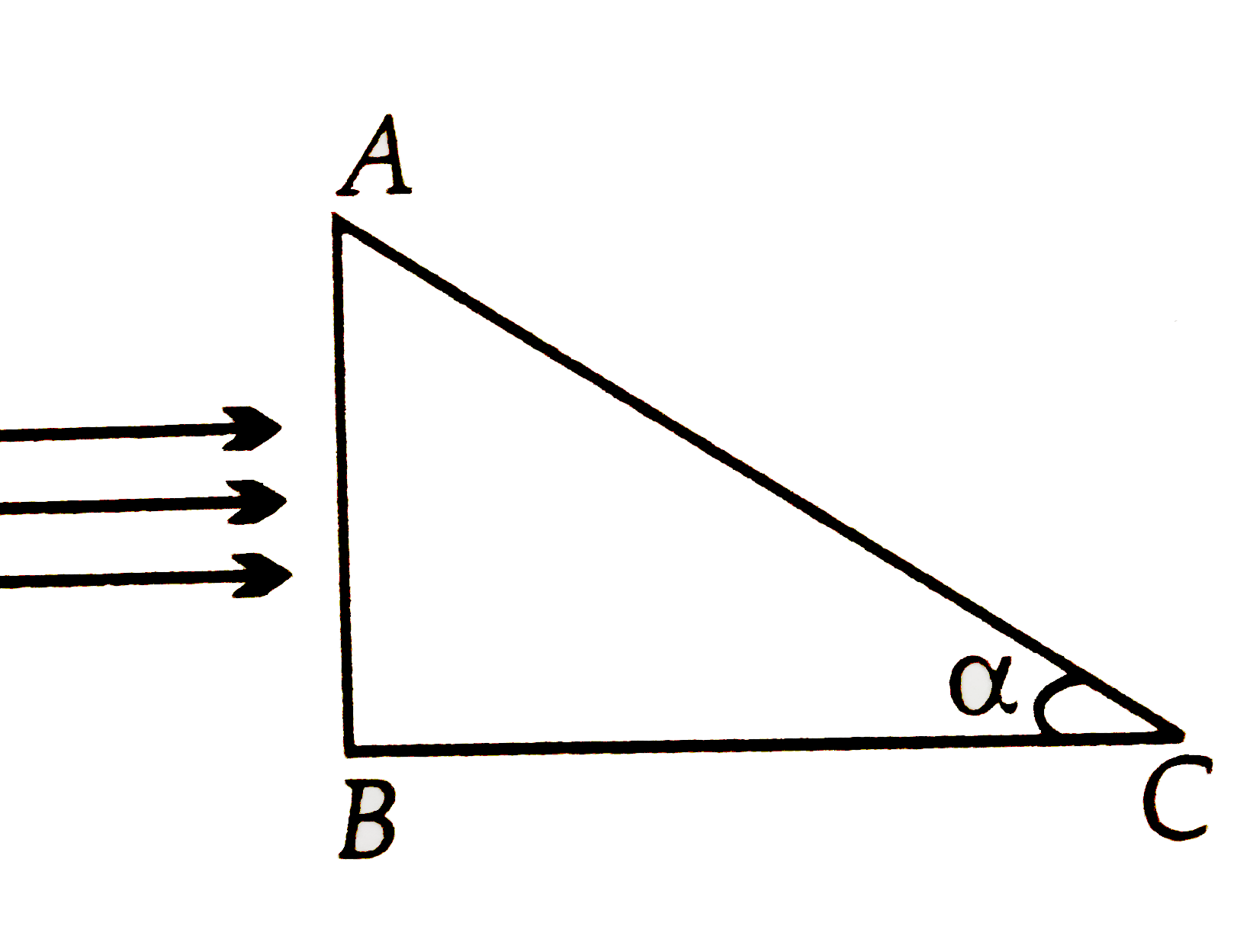A light ray is incident normally on the face AB of a right-angled prism ABC(μ==1.50) as shown in figure. What is the largest angle ϕ for which the light ray is totally reflected at the surface AC ?
 Solution in Gujrati
Solution in Gujrati
The correct Answer is:A, B, C
Let θc be the critical angle for the glass,
sinθcsin90∘)=1x
→sinθc=11.5=23
→θc=sin−123
for total interN/Al reflection 90∘=φ>θc
→θ<90∘=θc
→θ<cos−1(23)
so the largest angle for which light is totally reflected at the surface is cos−1(23)
Topper's Solved these Questions
Similar Questions
If the light moving in a straight line bends by a small but fixed angle it may be a case of
04:20View SolutionThe electric field in a region is given by →E=35E0→i+45E0→j with E0=2.0×103NC−1. Find the flux of this field through a recatngular surface of area 0.2m2 parallel to the y-z plane.
12:09View SolutionFind the range of frequency of light that is visible to an average human being (400nm<λ<700nm)
02:32View SolutionA light ray is incident normally on the face AB of a right-angled prism ABC(μ==1.50) as shown in figure. What is the largest angle ϕ for which the light ray is totally reflected at the surface AC ?
 01:41View Solution
01:41View SolutionThe path of a ray of light passing through an equilateral glass prism ABC is shown in figure. The ray of light is incident on face BC at the critical angle for just total internal reflection. The total internal reflection. The total angle of deviation after the refraction at face AC is 108^@ . Calculate the refractive index of the glass.
View SolutionA ray of light falls normally on one face of a right angled prims of refracting angle A. It suffers two total internal reflections before coming out of prism parallel to incident ray as shown. Refractive index to prism material will be:
 04:04View Solution
04:04View SolutionIn figure shown find the angle of incidence of the light ray on face AB of the prism for which light will reach face AC at incidence angle 60^(@) . [90^(@)]
03:21View SolutionA ray of light is incident normally on the prism (μ=32) immersed in a liquid as shown in the figure. The largest value for the angle α so that ray is totally reflected at the face AC is 30∘. The refractive index of the given liquid is
 02:08View Solution
02:08View SolutionThe face AC of a prism ABC of refracting angle 30∘ is silvered . A ray is incident on face AB at an angle of 45∘ as shown in figure . The refracted ray undergoes reflection at face AC and retraces its path . The refractive index of the prism is
 04:25View Solution
04:25View SolutionA ray of light is incident horizontally on the face AB of the.right angled prism as shown in the figure. If the ray emerges grazing the surface AC, find the value of ϕ. Refractive index of the material of the prism is given to be n.
 06:03View Solution
06:03View SolutionA light ray is incident normally on the face AB of a right-angled prism ABC(μ==1.50) as shown in figure. What is the largest angle ϕ for which the light ray is totally reflected at the surface AC ?
 03:38View Solution
03:38View SolutionA ray of light is incident normally on the prism (μ=32) immersed in a liquid as shown in the figure. The largest value for the angle α so that ray is totally reflected at the face AC is 30∘. The refractive index of the given liquid is
 04:56View Solution
04:56View SolutionA light ray is incident normally on the face AB of a right-angled prism ABC (μ=1.50) as shown in the figure. What is the largest angle ϕ for which the light ray is totally reflected at the face AC?
 11:11View Solution
11:11View SolutionAt what angle, a ray of light should be incident on the first face AB of a regular glass prism ABC so that the emergent ray grazes the adjacent face AC ?
05:00View SolutionA ray of light PQ is incident normally on the hypotenuse of a right angled prism ABC as shown in the diagram given below: What is the value of the angle of deviation of the ray ?
View SolutionThe path of a ray of light passing through an equilateral glass prism ABC is shown in figure. The ray of light is incident on face BC at the critical angle for just total internal reflection. The total internal reflection. The total angle of deviation after the refraction at face AC is 108^@ . Calculate the refractive index of the glass.
View Solution

